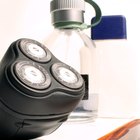
Repeatedly blowing your nose can wreak havoc on your nostrils. By constantly blowing your nose, you are drying out the delicate skin around your nose, as well as the nasal membranes inside your nostrils. You are also creating friction between the tissue and your nose, which leads to small cracks on the surface of the skin. Over time, these cracks penetrate deeper and cause the skin to become extremely raw, inflamed and painfully chapped. Fortunately, you can take a few steps to soothe the pain and encourage the area to heal.
Use a tissue that is ultra-soft and contains lotion or aloe. You can also purchase specially designed nose wipes that are moistened with saline, aloe and vitamin E for instant relief.
Blot your nose with the tissue instead of wiping or rubbing, which causes excess friction.
Wash your face gently with a mild moisturizing soap and cool to lukewarm water. Avoid facial scrubs and bars of soap, since these types of products can irritate and dry the skin out further. Rinse thoroughly and pat your face dry.
Squirt saline nasal spray into each nostril to help moisturize and heal the nasal membranes. Follow the product instructions and apply the saline solution throughout the day.
Place a soft, clean washcloth under cold running water and wring it out. Hold the washcloth against the inflamed area of your nose for 5 to 7 minutes. This quickly hydrates the delicate skin around your nose and helps soothe the pain.
Use steam to help stimulate your nose into secreting its own oils. Place a pot of water on the stove, and bring the water to a boil over high heat. Keeping a safe distance, lean your head over the pot and take slow, deep breaths as you inhale the steam. The steam reduces inflammation, relaxes your nasal passages and moisturizes the skin in and around your nose for immediate relief.
Place a small dab of petroleum jelly or triple antibiotic cream on a cotton ball or cotton swab. Gently rub the ointment into the affected areas after you have cleared and hydrated your nose. Reapply the ointment throughout the day to help protect your nose from chaffing and sooth the pain.
Apply other effective ointments such as sesame oil, vitamin E, aloe vera and eucalyptus oil. These oils help relieve congestion, create a protective barrier and reduce redness.
Dip a cotton swab into diluted tea tree oil. Rub the oil on the inside of your nose. Tea tree oil provides fast relief and eliminates bacteria.
Apply a thick coat of triple antibiotic ointment to your nose before bedtime. This ointment helps protect the skin, reduce swelling and even repairs the damage while you sleep.
Related Articles

How to Keep Eyeglass Nose Pieces From ...

Are There Ways to Get Rid of Blocked ...

How to Get Rid of Aftershave Allergies

How to Stop Bleeding From a Shaving ...

How to Tighten Loose Ligaments

The Best Vitamins for Sinuses

How to Repair Open Pores

How to Use Clearasil

How to Remove a Dilated Pore on the ...

How to Stop Stubble Itch

Remedies for Unblocking Stubborn ...

How to Get Rid of a Bump on Your Nose ...

How to Cover a Scab From a Zit

How to Get Rid of Irritation From ...

How to Get Rid of Dark Spots Around a ...

How to Use Vaseline as a Moisturizer ...

How to Stop a New Piercing From Itching

Peppermint Oil for a Cough

How to Use Vichy Normaderm

How to Soothe an Irritated Piercing
References
Writer Bio
Madison Rayne first started her writing career in May 2008. She has written numerous articles for various online publications. Rayne is currently pursuing a Bachelor of Science in accounting and psychology through Liberty University.
Photo Credits
Jupiterimages/Comstock/Getty Images